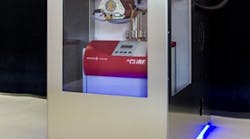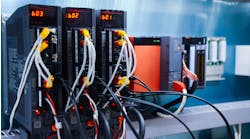For the first time, a mass spectrometer can analyze components in the liquid as well as the gas phase simultaneously in real time, claim its developers at the Fraunhofer Institutes for Chemical Technology (ICT), Pfinztal, Germany; and Interfacial Engineering and Biotechnology (IGB), Stuttgart, Germany. The instrument, dubbed foxySPEC, can detect up to 30 components without the need for prior separation. The device can play a role in automated monitoring and control of chemical reactions and biotechnological processes, the developers add.
Figure 1. New mass spectrometer can analyze simultaneously up to 30 components in the gas and liquid phases. Source: Fraunhofer IGB.
The instrument boasts a response time of less than 1 sec., a wide measurement range (10 ppb to 100%), and a detection limit in the low ppb range for gases and below 10µg/l for volatiles in liquids. Moreover, it requires sample volumes of only 1–10 sscm for gases and 1–100 ml for liquids. Gases are sucked by vacuum into the analyzer via stainless steel capillaries, eliminating the need for a pump. The ability for real-time monitoring depends upon the capillaries’ length (which can go up to 10 m) and diameter. The mass spectrometer also features auto-calibration.
A microporous membrane mounted on the bypass inlet on the unit allows analysis of components in the liquid phase. “Driven by the vacuum on the permeate side, volatile substances from the liquid sample vaporize and pass through the membrane,” explains Martin Joos of the ICT. The membrane is impermeable to polar liquids like aqueous solutions. Its three-dimensional structure reportedly resists clogging by solids.
[javascriptSnippet ]
In addition, the instrument features a newly developed sensor that enables in-situ analysis of liquids, e.g., in fermenters. “In such a case, the membrane, which is integrated into the measurement sensor, is located directly inside the reactor that is to be monitored,” notes Matthias Stier of IGB.
The two membrane inlet systems don’t display any cross-sensitivity and boast high long-term stability, claim the developers.
The foxySPEC instrument can handle liquids at pressures between 0 and 10 bar and temperatures of up to 100°C, and gases at pressures from 1 mbar vacuum to 100 bar and a maximum temperature of 400°C.
Fraunhofer is establishing a spin-off company to commercialize the technology and remotely maintain the units. Pfeiffer Vacuum, Asslar, Germany, is expected to distribute the first stand-alone version of foxySPEC in August 2017, notes IGB’s Stier. Fraunhofer is looking for partners to bring the technology to different fields of application, he adds.

